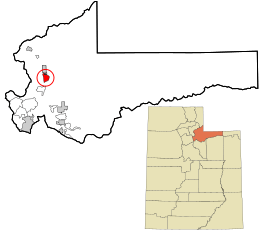Hoytsville, Utah facts for kids
Quick facts for kids
Hoytsville, Utah
|
|
|---|---|

Location in Summit County and the state of Utah
|
|
| Country | United States |
| State | Utah |
| County | Summit |
| Settled | 1859 |
| Founded by | Thomas Bradberry |
| Named for | Samuel P. Hoyt |
| Elevation | 5,706 ft (1,739 m) |
| Population
(2010)
|
|
| • Total | 607 |
| Time zone | UTC-7 (Mountain (MST)) |
| • Summer (DST) | UTC-6 (MDT) |
| ZIP code |
84017
|
| Area code(s) | 435 |
| GNIS feature ID | 2584768 |
Hoytsville is a small community located in western Summit County, Utah, in the United States. It is called a "census-designated place" (CDP). This means it's an area the government defines for gathering information, but it doesn't have its own city government.
Hoytsville was named after an early settler, Samuel P. Hoyt. It is bordered by Coalville to the north and Wanship to the south. In 2010, about 607 people lived there. A major highway, Interstate 80, passes through the area, and the Weber River flows nearby.
Hoytsville is home to a large chapel of the Church of Jesus Christ of Latter-day Saints, a cemetery, and a few local businesses and farms. Farmers in the area mainly focus on dairy farming (raising cows for milk), beef ranching (raising cows for meat), and raising sheep for their wool. In the past, people also raised mink here, but that industry has become much smaller recently.
You can also find the Hoyt Mansion in Hoytsville. The Summit County Historical Society considers it "one of the most elegant 19th Century homes still standing in Utah today."
Contents
Hoytsville's Early History
In 1859, a man named Thomas Bradberry and others started a settlement along the Weber River, which is now the Hoytsville area. At first, this settlement was called East Plymouth.
Building a Fort for Protection
During the Black Hawk War, which was a conflict in Utah, the settlers worked together to build a fort for safety. You can still see the foundation of this old fort in Hoytsville today. After the fort was built, the settlement's name was changed to Unionville.
Samuel P. Hoyt's Contributions
In 1863, Samuel P. Hoyt built the very first flour mill in Summit County. A flour mill grinds grain into flour. He also ran the local post office from his house. Because of his important contributions, the settlement was later renamed Hoytsville in his honor.
Historical Markers and Stories
The Mormon chapel in Hoytsville has a special historical marker, #37, placed by the Daughters of Utah Pioneers. This marker was put up on August 27, 1938.
The Old Fort and Grist Mill
The plaque on the marker tells us about the area's history:
"OLD FORT AND HOYT GRIST MILL This monument is near the site of the old fort, 300 ft. So. West of here. It was on Old Emigrant Trail. Route also used by overland stage and part of Johnston's Army going East in 1861, to participate in the Civil War. The fort was built during the Black Hawk War in 1866, on advice of Pres. Brigham Young to Bishop Winters. 25 families moved their log cabins there. Centrally located it provided protection for families, livestock and grist mill. The mill was the first in this county. Built in 1862 by Samual P. Hoyt."
This tells us that the fort was built in 1866 for protection during the Black Hawk War. It was a central place where about 25 families moved their log cabins for safety. The marker also confirms that Samuel P. Hoyt's mill was the first in the county, built in 1862. The area was also part of the Old Emigrant Trail, used by stagecoaches and even soldiers during the American Civil War.
People of Hoytsville
According to the census taken in 2010, there were 607 people living in Hoytsville. Most of the people (90.4%) were White. About 10.5% of the population identified as Hispanic or Latino.
Education in Hoytsville
Students in Hoytsville attend schools within the North Summit School District.
See also
 In Spanish: Hoytsville (Utah) para niños
In Spanish: Hoytsville (Utah) para niños

